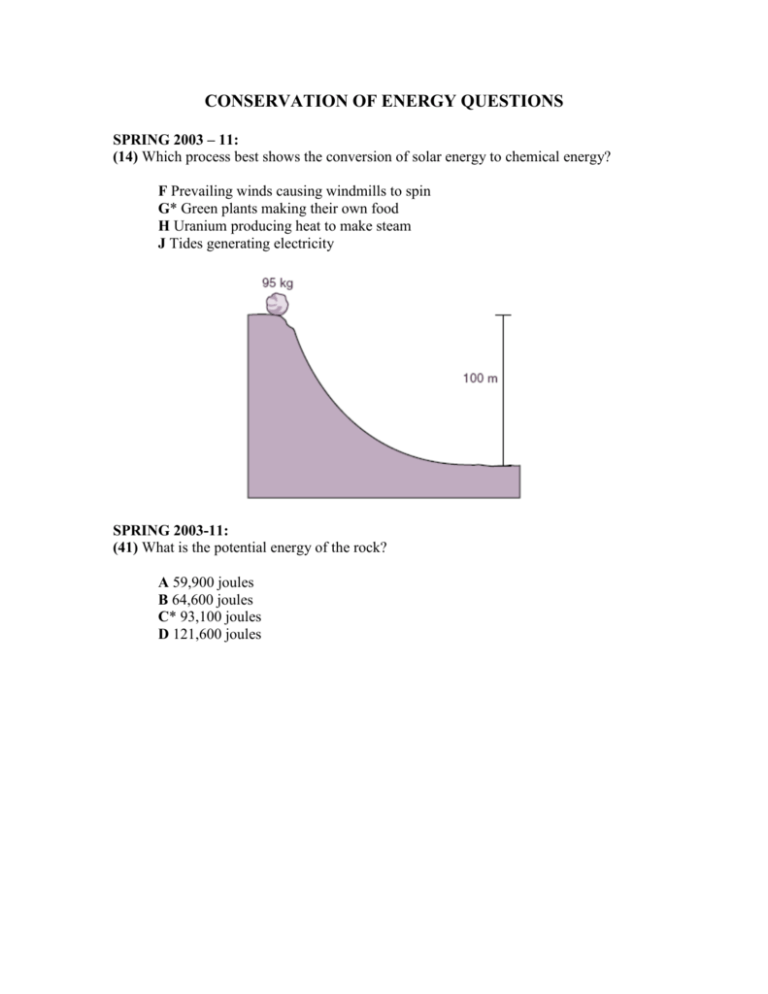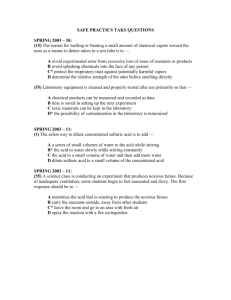Conservation_of_Energy
advertisement

CONSERVATION OF ENERGY QUESTIONS SPRING 2003 – 11: (14) Which process best shows the conversion of solar energy to chemical energy? F Prevailing winds causing windmills to spin G* Green plants making their own food H Uranium producing heat to make steam J Tides generating electricity SPRING 2003-11: (41) What is the potential energy of the rock? A 59,900 joules B 64,600 joules C* 93,100 joules D 121,600 joules APRIL 2004 – 10: Powerful Plankton The U.S. Naval Research Laboratory has created an experimental marine fuel cell that could produce enough electricity to power ocean-monitoring devices. This fuel cell runs on seawater and sediment, with the help of plankton. Some plankton on the surface of ocean sediments use dissolved oxygen to break down organic matter, releasing energy; this is an aerobic process. The plankton in the deeper sediments break down organic matter without using oxygen; this is an anaerobic process. These two processes create a difference in voltage between the surface of the sediment and the sediment farther down in the seabed. The voltage difference can be used to produce electricity—up to 5.0 10 – 2 watts of power. Energy supplied by this type of fuel cell can be obtained as long as there is organic matter in the sediment. (16) Fuel cells powered by plankton from the seabed can be used to operate instruments that monitor ocean currents and water temperature. These fuel cells get their energy by converting — F* chemical energy to electrical energy G electrical energy to mechanical energy H hydroelectric energy to geothermal energy J mechanical energy to chemical energy APRIL 2004 – 11: (12) Which of the following is an example of solar energy being converted into chemical energy? F* Plants producing sugar during the day G Water evaporating and condensing in the water cycle H The sun unevenly heating Earth’s surface J Lava erupting from volcanoes for many days APRIL 2004 – 11: (37) Why is the sum of the products’ energy in this reaction less than the sum of the reactants’ energy? A* Energy is given off as heat. B The products absorb available energy. C Energy is trapped in the reactants. D The reactants’ energy is less than the melting point of glucose. APRIL 2004 – 11: (48) An inventor claims to have created an internal combustion engine that converts 100 kJ of chemical energy from diesel fuel to 140 kJ of mechanical energy. This claim violates the law of conservation of — F momentum G inertia H* energy J mass APRIL 2004 – 11: (52) Assuming the chart contains all energy transformations in the Earth system, how much solar radiation goes toward evaporating water? F* 40,000 terajoules G 92,410 terajoules H 121,410 terajoules J 133,410 terajoules OCTOBER 2005 – 11: 52 According to the equation E mc2, mass — F travels at the speed of light G* can be transformed into energy H contains light energy J is doubled when exposed to light FALL 2005 – 11: 8 The temperature of the water increases by 8°C when the metal block is added. Which could cause the temperature of the water to increase by 10°C after the metal block is added? F. Using 500 g of water G. Using a larger beaker H. Adding more 20°C water J. *Adding heat to the metal block FALL 2005 – 11: 18 Because ancient Greeks lived close to water, they may have enjoyed a more constant climate than if they had lived inland. Water warms up and cools down more slowly than land. This is because of water’s — F boiling point G* specific heat H melting point J specific gravity FALL 2005 – 11, FEBRUARY 2006 – 11, JULY 2006 - 11: 46 What is the approximate difference in gravitational potential energy of the two shaded boxes? F 19 J G* 39 J H 59 J J 79 J








